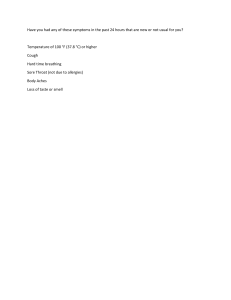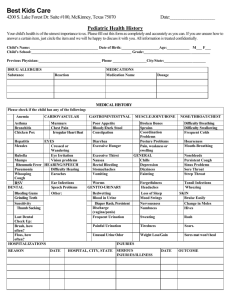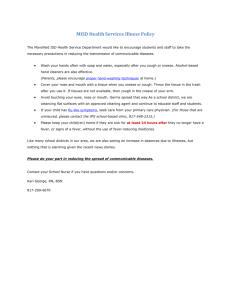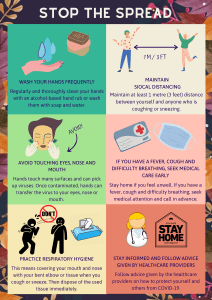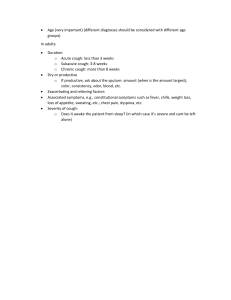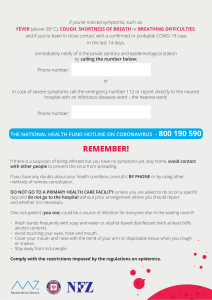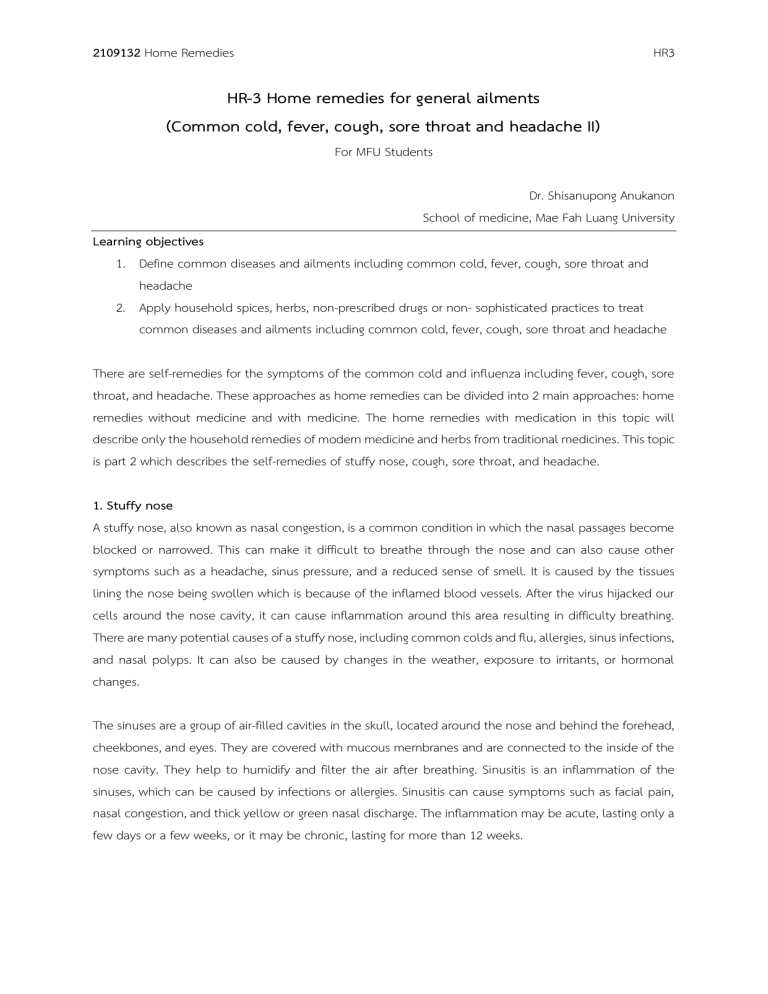
2109132 Home Remedies HR3 HR-3 Home remedies for general ailments (Common cold, fever, cough, sore throat and headache II) For MFU Students Dr. Shisanupong Anukanon School of medicine, Mae Fah Luang University Learning objectives 1. Define common diseases and ailments including common cold, fever, cough, sore throat and headache 2. Apply household spices, herbs, non-prescribed drugs or non- sophisticated practices to treat common diseases and ailments including common cold, fever, cough, sore throat and headache There are self-remedies for the symptoms of the common cold and influenza including fever, cough, sore throat, and headache. These approaches as home remedies can be divided into 2 main approaches: home remedies without medicine and with medicine. The home remedies with medication in this topic will describe only the household remedies of modern medicine and herbs from traditional medicines. This topic is part 2 which describes the self-remedies of stuffy nose, cough, sore throat, and headache. 1. Stuffy nose A stuffy nose, also known as nasal congestion, is a common condition in which the nasal passages become blocked or narrowed. This can make it difficult to breathe through the nose and can also cause other symptoms such as a headache, sinus pressure, and a reduced sense of smell. It is caused by the tissues lining the nose being swollen which is because of the inflamed blood vessels. After the virus hijacked our cells around the nose cavity, it can cause inflammation around this area resulting in difficulty breathing. There are many potential causes of a stuffy nose, including common colds and flu, allergies, sinus infections, and nasal polyps. It can also be caused by changes in the weather, exposure to irritants, or hormonal changes. The sinuses are a group of air-filled cavities in the skull, located around the nose and behind the forehead, cheekbones, and eyes. They are covered with mucous membranes and are connected to the inside of the nose cavity. They help to humidify and filter the air after breathing. Sinusitis is an inflammation of the sinuses, which can be caused by infections or allergies. Sinusitis can cause symptoms such as facial pain, nasal congestion, and thick yellow or green nasal discharge. The inflammation may be acute, lasting only a few days or a few weeks, or it may be chronic, lasting for more than 12 weeks. 2109132 Home Remedies HR3 1.1 The self-remedies without medicine The self-remedies without medicine when suffering from stuffy noses either infection or noninfection causes include wiping the fluid out, using nasal irrigation, breathing hot water vapor, rubbing vapo rub, and eucalyptus oil. 1.1.1 Wiping the fluid out with tissue paper may not be considered as self-remedy but advice instead of blowing the nose. Blowing the nose during partial nose obstruction may produce high pressure to return into our lungs and destroy them. Moreover, blowing the nose may drive the virus or bacteria deep into the sinuses resulting in sinusitis (infection of the sinuses). 1.1.2 Nasal irrigation, also known as nasal lavage is a technique used to clean the nasal passages and sinuses. It involves flushing out the nasal passages with a saltwater solution (saline), which can help to remove mucus, allergens, and other irritants resulting in enhancing breathing. It is one of the best self-remedies for relief from a stuffy nose and runny nose. The instruction for nasal irrigation is to place a saline-filled syringe inside the nose with the tip of a syringe (should not be deeper than 1/2 inch), keep the mouth open, and push the syringe to pour the saline into the nostrils, allowing it to flow through the nasal passages and out the other nostril. Blow your nose gently to remove any remaining solution and then repeat the process on the other side. Please noted that during irrigation should not breathe through the nose, breathing through the mouth is a suggestion. It's important to note that you should not use tap water for nasal irrigation, as it may contain bacteria or other contaminants that can cause infections. If you have any doubts or concerns, it is best to consult with a health professional before using this method. 1.1.3 Breathing hot water vapor or steam can help to relieve a stuffy nose by loosening and thinning out mucus, making it easier to clear from the nasal passages. Steam inhalation can also help to reduce inflammation and swelling in the nasal passages, which can make it easier to breathe. The heat and moisture in the steam can also help to soothe a sore or irritated throat. There are several ways to inhale steam: Take a hot shower and breathe in the steam. Fill a bowl with hot water and put your face over it with a towel draped over your head to trap the steam. Use a humidifier to add moisture to the air in your home. 2109132 Home Remedies HR3 1.1.4 Chest rub is a common name for topical ointments used to relieve symptoms of nasal congestion and muscle aches. VapoRub is one of the most well-known brands of this type of product, but there are many other brands available as well. Vapo rub consists of camphor, eucalyptus oil, and menthol in the ointment bases. Camphor and menthol have cooling effects on the body (if you apply them to the body) which help feel better. Eucalyptus oil is an essential oil that has been reported to remove all nasal blockages. Rubbing on the warm area such as the chest and throat, can enhance these ingredients evaporate and pass through the nose effectively. A vapor inhaler is a device that releases this vapor into the air. These are typically used to relieve symptoms of nasal congestion and coughing by opening up the airways and making it easier to breathe. Even though all of these vapor preparations have poor evidence to remove nasal congestion directly but their cooling effect may help feel better. 1.1.5 Spicy decongestants are a type of home remedy that some people use to relieve symptoms of stuffy noses associated with colds, flu, or sinus infections. The idea behind using spicy foods as a decongestant is that the capsaicin in spicy peppers can help to open up the nasal passages and make it easier to breathe. One way to use this is by adding spicy foods such as cayenne pepper, black pepper, chili powder, or hot sauce to meals or making a hot drink such as ginger tea, adding some black pepper and cayenne pepper. The other popular spicy decongestant is wasabi, a spicy green paste that is made by crushing the stem of the Japanese wasabi plant. Many believe that real wasabi paste has powerful decongestant activity. Eating wasabi makes our nostrils flare (burn with a sudden intensity), which allows more air into our noses like chili. It's important to note that spicy decongestant is not a substitute for medical treatment, and they may not be suitable for everyone. Some people may be more sensitive to spicy foods and may find that it causes irritation or burning in the nose or throat. 1.2 The self-remedies with medicine The medicine when suffering from a stuffy nose is decongestant medication. This medication belongs to a combination remedy in several brands such as Actifed® and Sulidine®, that consists of triprolidine (antihistamine or anti-allergic drug) together with phenylephrine (decongestant). In terms of regulation issues, this formula does not classify as household remedies. They are classified as a ready-packed drugs or dangerous drugs that buy or be prescribed only at hospitals and pharmacies (drugstores). 2109132 Home Remedies HR3 2. Cough A cough is a reflex (reaction) that helps to clear the airways of mucus, foreign particles, and irritants through the heavy breathing passages. The cough is triggered when sensors in the airways detect an irritation or obstruction. This sends a signal to the brain, which then sends a signal to the muscles that control breathing to forcefully exhale air from the lungs. This creates a strong flow of air that helps to clear the airways. The common causes of cough include the cold and flu, inhaling an irritant (such as smoke, dust, chemicals, or a foreign body), pneumonia, allergies, asthma (most common in children), and gastroesophageal reflux disease (GERD). Cough is different from sneezing because sneezing causes the result of driving out of air suddenly coming out of the nose, not the throat. The common causes of sneezing include allergy to pollen (hay fever), mold, dander, and dust; cold or flu; and triggers such as dust, air pollution, dry air, spicy foods, strong emotions, certain medicines, and powders. There are many types of cough including dry cough, cough with phlegm (เสมหะ) or productive cough, cough with a wheeze and trouble breathing, chronic or persistent cough, and coughing up blood. The coughs that you need to seek the medical doctor are cough with a wheeze or trouble breathing, chronic or persistent cough, and coughing up blood, DO NOT use home remedies to relieve these symptoms. It is important to note that, sometimes, coughing can be a sign of a more serious underlying condition, such as lung cancer or chronic obstructive pulmonary disease (COPD). If you have a persistent cough or a cough that is accompanied by other symptoms, such as chest pain, shortness of breath, or blood in the phlegm, it is best to consult with a doctor for proper diagnosis and treatment. 2.1 The self-remedies without medicine 2.1.1 Drink plenty of water; Sipping warm water every hour during cough can soothe our throat from cough and loosens the phlegm which is easy to expel. Not only warm water, but all kinds of hot especially chicken soup, and tea, are also good home remedies for relieving cough. 2.1.2 Avoid smoking; Tobacco smoking causes retarding of the movement of hair cells in the inner layer of the throat which makes the throat unable to expel foreign particles or mucus from the throat and airways. 2.2 The self-remedies with medicine 2.2.1 Sip cough syrup: The famous cough syrup is called Brown's mixture. This medication belongs to a household remedy that consists of glycyrrhiza fluid extract (สารสกั ด ชะเอม), 2109132 Home Remedies HR3 antimony potassium tartrate, and camphorated Opium tincture. Glycyrrhiza fluid extract, the main ingredient separating from licorice (so-called sweet wood) may decrease cough by soothing the throat and loosening the phlegm which is easy to expel. Antimony potassium tartrate promotes the secretion of water in the throat that helps loosen mucus to cough it up. Camphorated Opium tincture is a cough suppressant together with promoting the secretion of water. Camphorated Opium tincture has a very small amount of morphine which makes it less addictive. Taking these medications 5-10 mL (or 1-2 teaspoons) 3-4 times a day. 2.2.2 Self-remedies with Thai traditional medicine: There are various formulas for relieving cough particularly productive cough including ยาอามฤควาที, ยาประสะมะแว้ง , and ยาแก้ไอผสมมะขามป้อม. The effect of these formulas is similar to glycyrrhiza extract which decreases cough by soothing the throat and loosens the phlegm which is easy to expel. Taking these medications 5-10 mL (or 1-2 teaspoons) 3-4 times a day. 2.3 Natural remedies for relieving cough 2.3.1 A recipe consisting of lemon with ginger and honey can relieve cough. Lemon (or lime) and ginger reduce cough by promoting the secretion of water in the throat that helps loosen mucus to cough it up. Honey has antimicrobial, anti-inflammation, and soothing effects to promote the effect of lemon and ginger. 2.3.2 Turmeric (ขมิ้ น ชั น ) has a benefit for relieving chronic cough. It exerts antibacterial, and antifungal which help get rid of microbes surrounding the throat. Mix a glass of warm milk with 1/4-1/2 teaspoons of turmeric powder and drink two times a day during a cold and cough. 2.3.3 There are many types of basil that are used as a favor in some types of foods. In Thailand, three types of basil are usually used including sweet basil (or Thai basil, โหระพา), holy basil (กระเพรา), and hairy basil (or lemon basil, แมงลัก). There are many types of basil that are used as a favor in some types of foods. In Thailand, three types of basil are usually used including sweet basil (or Thai basil, โหระพา), holy basil (กระเพรา), and hairy basil (or lemon basil, แมงลัก). Holy basil is the most type which commonly uses for relieving cough, especially productive cough. Holy basil is also believed to have expectorant properties, which means it helps to clear mucus and phlegm from the respiratory tract. This can also help to relieve coughing and other symptoms associated with respiratory infections. Just chewing 2-4 leaves of holy basil 2-3 times a day may decrease cough by expelling phlegm and strengthening our immune system. 2109132 Home Remedies HR3 2.3.4 Herbal tea can relieve irritation and itching in the throat which results in a decrease in the frequency of the cough. Many herbs have properties that can help to soothe the throat, reduce inflammation, and clear mucus from the respiratory tract. Some examples of herbs that may be helpful for relieving a cough include: Peppermint: Peppermint has menthol which is known to have a cooling effect on the throat and can also help to ease coughing and other respiratory symptoms. Thyme: This herb contains compounds that have antimicrobial properties, which can help to fight off respiratory infections. It also has expectorant properties, which means it can help to clear mucus from the lungs. 3. Sore throat A sore throat is pain or irritation of the throat that often makes it difficult to swallow. It can also feel dry and scratchy (feel itchy within your throat). The causes of sore throat mostly come from viral or bacterial infections that result in inflammation of the lymph nodes, tonsils, and throat. If this pain is long-lasting for more than 3 days, please see a doctor. The self-remedies when we got a sore throat are quite similar to self-remedies of fever and cold. Gargle with saltwater, turmeric water, cinnamon, and pepper water can wash the mouth and throat to remove any mucus and foreign particles in our throat. Andrographis stimulates the immune system which helps you to fight bacteria or viruses. Ginger promotes sweating to reduce fever symptoms and its carminative effect (prevent the formation of gas in the digestive system) helps the patient's digestion better. Honey has antimicrobial, anti-inflammation, and soothing effects. Painkiller drugs when we got a sore throat are paracetamol, ibuprofen, etc. The dose and frequency are similar to the dose and frequency for relieving cold and flu. Most sore throats will get better within one week without antibiotics. What is the meaning of antibiotics? Antibiotics are drugs that kill or stop the growth of bacteria. Most antibiotics are classified as dangerous drugs (the medication that requires a physician or pharmacist to prescribe), while some are specially controlled drugs. A doctor or pharmacist may prescribe antibiotics such as penicillin or amoxicillin when they confirm that a sore throat is caused by a bacterial infection. If a sore throat is caused by a virus, antibiotics will not help. 2109132 Home Remedies HR3 4. Headache Headache is a symptom that involving of pain anywhere in the region of the head or neck. There are many causes of headaches including stress, changes in sleep, poor posture, alcohol, and some food. The food that causes headaches includes aged cheese (blue cheese, cheddar, mozzarella, parmesan, swiss) peanuts, peanut butter, almonds, and other nuts and seeds. 4.1 The self-remedies without medicine The self-remedies without medicine when suffering from headaches are resting in a quiet dark room, a cool compress on the forehead, a hot compress on the back of the neck, or massaging the neck and shoulders. 4.2 The self-remedies with medicine The self-remedies with medicine or natural remedies when suffering from headaches include painkiller drugs, a paste made of clove and salt crystals in milk, cinnamon powder, coconut oil, and betel leaves. 4.2.1 Painkiller drugs are paracetamol, ibuprofen, etc. The dose and frequency are similar to the dose and frequency for relieving colds and flu. 4.2.2 A paste of clove and salt crystals; A paste made from clove and salt crystals in milk. Clove is an aromatic flower bud, in Thai called กานพลู . To prepare this paste, grind 1 - 2 dried cloves with 1 tablespoon of table salt and a small amount of milk. Apply this mixture on the forehead or neck to reduce the intensity of the headache. 4.2.3 Cinnamon powder has analgesic and antipyretic effects which help you to relieve headaches. Apply this paste which is made from cinnamon powder, salt, and milk on the head for headaches caused due to exposure to cold air. 4.2.4 Coconut oil; Massaging with coconut oil on the forehead and neck for 15-20 minutes can help reduce headaches, particularly headaches in the summer season. 4.2.5 Betel leaves (ใบชะพลู ) have analgesic and cooling properties. Applying the crushed form of these leaves on the forehead or the center of the head can reduce the severity of headaches.
